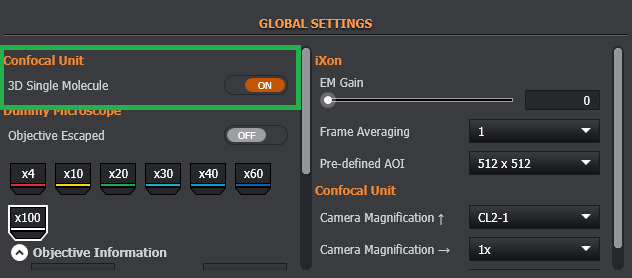Creating 3D SMLM Protocol
To retrieve the 3D information for the SMLM data the 3D super-resolution module needs to be calibrated. go to Calibrate 3D Super Resolution Module to see how to acquire images to calibrate the 3D super-resolution module.
A single plane image plane acquired with the 3D Super-resolution module engaged delivers axial information over an ~ 1 μm range with a corresponding resolution down to 30 nm.
Acquiring Super Resolution images can be complex. If the sample is hard to focus on, start by focusing the sample in Widefield imaging modality, using the appropriate WF channel for the sample.
SMLM data can be acquired in any imaging modality: widefield, confocal or B-TIRF. The user should select the imaging modality depending on experimental requirements and goals. Widefield will deliver more background than the other imaging modalities. Confocal will acquire super-resolution data in thicker sections. B-TIRF will deliver more S/B (Signal to Background) and as such will deliver a better localization precision on the final result.
Select the appropriate channel and imaging mode for the experiment.
Select Finite Burst protocol
In this protocol add the desired imaging channel
A good starting point would be a burst of 10 000 frames.
Adjust laser and exposure time to have a good S/B.
Engage the 3D super-resolution module - the 3D Single Molecule is switched on within Confocal Unit global settings within the channel manager.

Acquire protocol.
The video below shows an example of the 3D - SMLM acquisition.